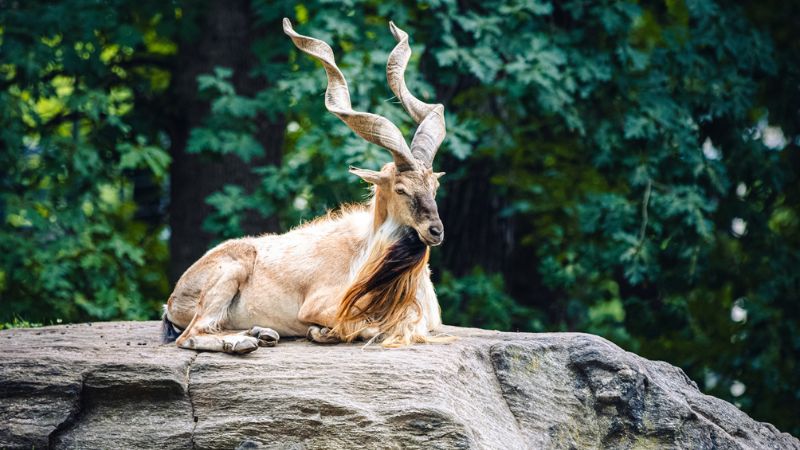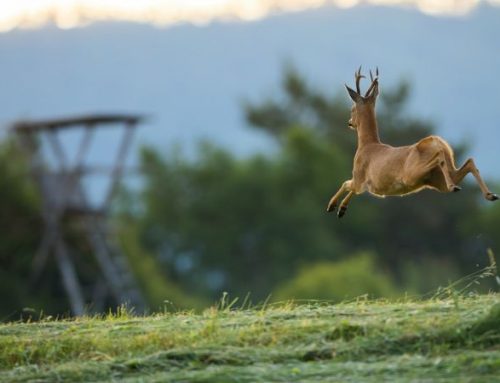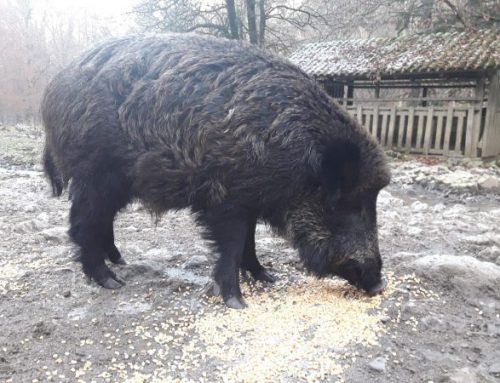Markhor hunting is not just a hunting expedition, but an inner pilgrimage. A journey along suspended trails, between wind-carved ridges and valleys that whisper ancient stories.
It is the hunt for the Markhor, the king of the Central Asian mountains, the animal that more than any other embodies the myth of challenge, wild elegance, and absolute respect.
The name “Markhor” means “snake eater”—and that alone is enough to evoke its legendary aura. But beyond the name, it is its presence that speaks: noble, silent, elusive. The Markhor lives among the rugged peaks of Pakistan, Tajikistan, and Uzbekistan, where sheer rock walls merge with the sky, and man is nothing more than a respectful guest.
Morphology and Charisma of a Unique Animal
The Markhor is a large wild goat, powerful yet graceful, with a feature that makes it truly one of a kind: spiral horns that can reach up to 160 cm in mature males. These horns, twisted like the trunk of an ancient olive tree, are among the most sought-after and symbolic trophies in the entire world of hunting.
Its coat ranges from ashen gray to golden brown, with darker shades in the winter season. The flowing beard of the adult male dances in the wind like a mountain banner, and every step reveals balance and strength. This is an animal accustomed to life at extreme altitudes—often above 3,000 meters—moving with ease where man struggles to keep pace.
Geographic Context: Where the Markhor is Hunted
The areas where the Markhor is hunted are among the wildest and most captivating on Earth—true natural sanctuaries suspended between land and sky. In particular, the mountains of Gilgit-Baltistan in northern Pakistan offer landscapes seemingly carved by time: dizzying cliffs, deep gorges, rushing torrents, and alpine expanses where the wind whispers tales of ancient peoples. The trails leading to these heights have been walked for generations by shepherds, traders, and hunters—each step steeped in a silent, powerful energy.
In Chitral, one crosses snow-covered plateaus and forests of fir and cedar, while in Torghar, in Balochistan, the landscape shifts dramatically: more arid, bare, and yet incredibly evocative, with rocky canyons hiding pockets of green oasis.
In the Tajik Pamirs, the hunt unfolds in less wooded but equally remote settings: windswept, barren plateaus of rock and stone, where altitudes often exceed 4,000 meters and the sense of solitude is absolute. Here, the sky feels closer, and the land seems to speak only the essential.
Each territory presents its own challenges: razor-sharp ridges, rugged paths, and a lack of clear markers. But in every one of them, the Markhor finds refuge—and the hunter finds his challenge.
Hunting the Markhor takes place in remote and extraordinary mountainous regions, primarily in northern Pakistan, along the Hindu Kush mountain range, in the valleys of Gilgit-Baltistan, Chitral, Torghar, and the Kohistan district. Outside of Pakistan, a limited number of permits are also available in Tajikistan and Uzbekistan, in certain areas of the Pamir Plateau—but it is Pakistan that truly represents the homeland of this legendary animal.
The landscape is breathtaking: sheer rock walls, razor-sharp ridges, glacial valleys dotted with stone villages, and forests of juniper and birch. In summer, the slopes turn green and smell of alpine grass; in winter, snow blankets everything, creating a total silence broken only by the wind.
The best time for hunting runs from November to February, when snow covers the highest elevations and herds descend to lower ground in search of pasture. It is also the rutting season, when males compete for females and are more easily observed in action.
The climate is cold and dry, with significant temperature swings between day and night. Days may be sunny, but temperatures often stay below freezing, especially at high altitudes. Technical clothing and strong physical conditioning are essential to face the elevation, wind, and thin air.
Habits of the Lord of the Rocks
The Markhor is an elusive, vigilant, and solitary animal. It prefers steep slopes, deep gorges, and inaccessible faces where it can observe without being seen. It is most active at dawn and dusk, when it leaves its ledges to graze on shrubs, mosses, and alpine plants.
Its hearing and eyesight are incredibly sharp—capable of detecting the slightest movement from hundreds of meters away. Because of this, approaching it requires days of hiking, endless hours of glassing, and complete silence. Every heartbeat, every step on loose gravel can make the difference between success and disappearance.
A Hunt That Is a Mountain Rite
Hunting the Markhor is not simply the pursuit of a trophy: it is the pursuit of an ideal of perfection, of wild beauty that allows itself to be approached only by those who accept the rules of altitude and slowness.
The expedition begins in a small Himalayan village, from which you cross glacial rivers, nomadic shepherd camps, and sacred forests. Then the ascents begin: miles on foot, light loads, and a light spirit. The local guides know every ridge, every spot where the wind shifts and the sun deceives.
And when, at last, the herd is spotted—poised on a distant cliff—the heart races. It may take hours, perhaps days, to get closer. But it is in that waiting, in that silent respect, that the magic unfolds. The shot is never the goal, but the conclusion of a journey into the essence of hunting.
Recommended Rifles and Calibers
To take on such a demanding hunt as that of the Markhor, choosing the right firearm is crucial. These are shots often taken at long distances, on steep terrain, and in ever-changing weather conditions. You need a rifle that is precise, lightweight to carry, and capable of remaining reliable in hostile environments.
The most recommended calibers for hunting the Markhor include:
-
.300 Winchester Magnum – ideal for its accuracy and the power needed to ensure an ethical kill even beyond 300 meters;
-
.308 Winchester – suitable for medium-range shots, offering a good balance between recoil and precision;
-
.270 WSM (Winchester Short Magnum) – excellent for its flat trajectory and bullet speed;
-
6.5 PRC – increasingly appreciated for long-range mountain shots.
The ideal is to pair the rifle with optics featuring ballistic turrets, illuminated reticles, and great brightness, essential elements in low-light conditions and for accurately assessing distance and trajectory.
The shot may take place from very unstable positions, so it is recommended to train with supports such as tripods, shooting bags, or sticks and simulate real situations during preparation.
Physical preparation: Condition is everything
Facing the Markhor hunt requires more than just experience and skill with the rifle: it requires physical endurance, mental balance, and environmental adaptability.
Before departure, it’s crucial to start specific training, ideally 2-3 months in advance. The program should include:
daily uphill walks with a backpack (10 to 15 kg);
resistance exercises (cardio, running, cycling, treadmill with incline);
Functional training to strengthen legs, back, and core;
shooting simulation sessions at high altitudes to get used to managing an elevated heart rate and stress in difficult conditions.
The mountainous environment of the Karakoram and Pamir does not forgive: narrow paths, steep climbs, thin air. Even an excellent hunter can find himself in difficulty if he has not acclimatized to the altitude and does not have a body prepared to endure hours and hours on uneven terrain.
Mental preparation is also important: patience, the ability to withstand cold, loneliness, and waiting. Those who prepare carefully already have an advantage.
The value of an ethical choice
Hunting the Markhor is strictly regulated: only a few permits are granted each year, distributed through conservation programs and public auctions. 70-80% of the proceeds go directly to local communities, who actively protect the animal’s habitat and combat poaching.











